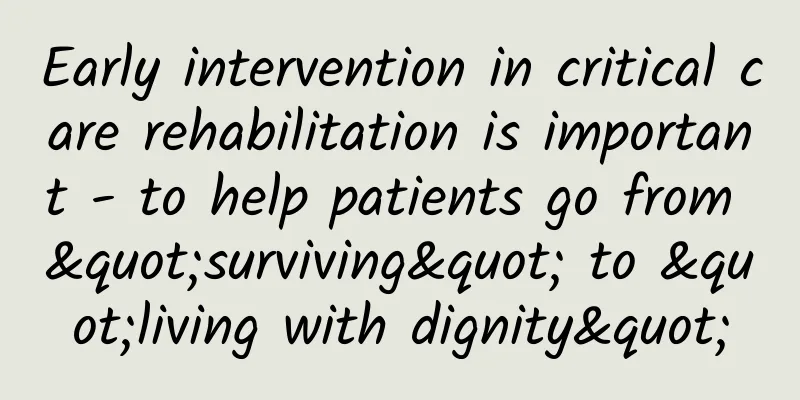Early intervention in critical care rehabilitation is important - to help patients go from "surviving" to "living with dignity"

|
Help patients go from "surviving" to "living with dignity" Early intervention in critical care rehabilitation With the rapid development of critical care medicine, the mortality rate of patients in intensive care units has been significantly reduced. However, after successfully saving lives, patients often face the risk of a series of complications, such as limb dysfunction and cognitive impairment. These disorders have long-term effects not only on the patients themselves, but also on their families and social security systems. How to improve the functional recovery and quality of life of patients after rescue has become an issue of great concern to all sectors of society. What is a critically ill patient? Severely ill patients usually refer to patients who are in critical condition, bedridden for a long time, or rely on special medical support. For example, patients with stroke, severe pneumonia, coma after trauma, etc., face complex medical and rehabilitation needs. Without timely rehabilitation intervention, critically ill patients may face a series of serious consequences: Dystonia: Causes muscle cramps or weakness. Varicose veins: Resting in bed for a long time can lead to poor blood circulation in the lower limbs. pneumonia: Decreased respiratory function due to bed rest. Muscle atrophy: Lack of activity leads to weakened muscles. Restricted activity: Muscle and joint problems together affect a person's ability to carry out daily life. Bedsores: Long-term pressure on the skin causes ulcers, seriously affecting the quality of life. Why is early intervention of rehabilitation assistive devices necessary? Preventing complications Severely ill patients are very likely to develop complications when they are bedridden for a long time or have limited mobility. These problems not only increase the patient's pain, but may also lead to serious functional loss and even increase the risk of secondary hospitalization. The risk of these problems can be effectively reduced through early intervention rehabilitation training and the use of appropriate assistive devices, such as ankle-foot orthoses, cushions and turning pads. Promote functional recovery Severely ill patients often have reduced mobility and greatly weakened self-care ability due to disease or treatment limitations. Early scientific rehabilitation intervention can help patients gradually restore limb function and improve body coordination and strength. Improve quality of life Through the use of personalized rehabilitation aids, such as portable respiratory assistance equipment, orthotics and life-assistive tools, patients can gradually regain independence and reduce their dependence on home care. At the same time, psychological rehabilitation intervention can also relieve patients' anxiety and depression, so that they can get comprehensive support psychologically and physically, thus achieving a more positive and meaningful life. What are rehabilitation aids? Rehabilitation assistive devices are any products that can prevent, compensate, monitor, alleviate or reduce injuries, activity limitations and participation restrictions. These assistive devices combine medical and engineering technologies to provide patients with physical support, functional compensation and improved independence in life, and are an important part of rehabilitation treatment. Limb correction: Ankle-foot orthoses (AFOs), knee orthoses, etc. are used to support or stabilize the limbs and improve posture and function. Mobility assistance: Wheelchairs and walkers help patients stand or walk and improve their mobility. Functional training class: Includes a variety of rehabilitation training equipment to help patients improve muscle strength, coordination and flexibility. Assistive device example: Ankle-foot orthosis (AFO) The role of ankle-foot orthoses in critical care rehabilitation Ankle-foot orthosis (AFO) is a commonly used support device in critical rehabilitation, mainly used to help patients recover lower limb function due to long-term bed rest, nerve damage or muscle dysfunction. It supports and stabilizes the ankle joint, assisting patients to gradually move from bed rest to standing and walking, and is one of the important tools for the functional recovery of critically ill patients. Classification 1. Static ankle-foot orthosis Static ankle-foot orthosis puts the ankle joint in a functional position and improves foot drop, ankle valgus and valgus deformity. 2. Dynamic ankle-foot orthosis The difference between a dynamic ankle-foot orthosis and a static ankle-foot orthosis is that the ankle joint of the dynamic ankle-foot orthosis is movable, which allows the ankle joint to have dorsiflexion and flexion functions. Applicable scenarios 1. Correction of foot drop Severely ill patients often experience foot drop due to nerve damage (such as stroke or traumatic brain injury), resulting in unstable gait or inability to walk. Ankle-foot orthoses can fix the ankle in the proper position, prevent toes from dragging on the ground, and improve gait. 2. Insufficient muscle support Long-term bedridden patients are often accompanied by muscle atrophy, especially weak lower limb muscles. Ankle-foot orthoses provide external support to assist patients in standing and walking. 3. Prevent deformity Long-term bed rest or poor posture may lead to foot deformities such as inversion and eversion. Wearing an ankle-foot orthosis can keep the joint in a neutral position and prevent further development of the deformity. 4. Assistance in gait training When critically ill patients gradually transition from bedside training to gait training, ankle-foot orthoses can stabilize the joints, balance the body, and help patients adapt to gait recovery training more quickly. Early rehabilitation is an important step in the recovery of critically ill patients. The correct use of assistive devices, combined with the help of a professional team, can help patients regain dignity and hope in life. We are committed to providing scientific and personalized rehabilitation support for every patient. Welcome to consult us and work with doctors to develop a rehabilitation plan. |
<<: Is it more convenient and easier for the elderly to drink juice than to eat fruit?
Recommend
Leucorrhea like snot with blood
Bloody vaginal discharge may be a symptom caused ...
Live broadcast | Are you ready? A "Spring Health Carnival" is waiting for you to participate!
Listen to health science lectures by experts and ...
Are tampons comfortable to use?
Ever since women started menstruating, they have ...
Why do girls' breasts grow bigger?
When girls begin to enter puberty at the age of 1...
Clinical manifestations of uterine hyperplasia polyps
In real life, many women have encountered uterine...
39 weeks, occasional vaginal pain
People often say that pregnancy takes ten months,...
The trouble with Quora: Very low brand awareness
July 30, 2012, according to foreign media reports...
How to regulate female ovarian endocrine disorders?
I believe many female friends have heard of the d...
What causes a hard stomach in the morning during pregnancy?
Many pregnant women experience hard stomachs in t...
Benefits and changes after IUD removal
The IUD can effectively play the role of contrace...
Can I eat goose during menstruation?
What to eat during menstruation has always been a...
What should patients with liver disease pay attention to in their diet and lifestyle?
Liver disease is a group of clinical conditions t...
Is it normal to have frequent fetal movements at 4 months?
The baby in the pregnant woman's belly has gr...
No menstruation but lower abdominal pain
Women's monthly menstruation is mainly for th...
The reason why my aunt has diarrhea during her period
Menstruation is a physiological phenomenon of wom...









